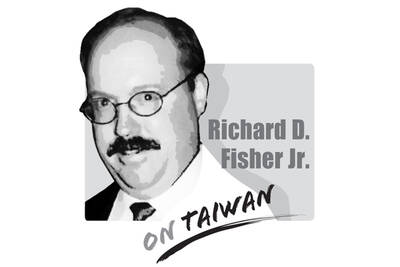During an exclusive interview with Agence France-Presse late last month, President Tsai Ing-wen (蔡英文) called on the international community to constrain “China” together.
Former National Security Council secretary-general Su Chi (蘇起) commented that as Tsai used the word “China,” and not the phrase “mainland China,” she revealed her concept of “one country on each side.”
Su said that as Tsai advocates winning over the world against China, she is walking from cross-strait reconciliation to confrontation, and reconciliation is unreachable unless Taiwan recognizes itself as a part of China.
However, legally and from the Taiwanese public’s subjective self-awareness, Taiwan is not a part of China.
For the former, the issue can be divided into three aspects according to international convention: succession of state, international treaties and de facto occupation.
First, in terms of succession of state, the People’s Republic of China (PRC) did succeed the Republic of China (ROC) in China. The problem is, when the ROC’s draft constitution was announced on May 5, 1936, Article 4 divided the nation’s territory into 30 areas, but Taiwan was not included, because it was under Japanese colonial rule.
When the ROC Constitution was promulgated in 1947, it did not alter the territory of the nation. Obviously, Taiwan does not belong to China under such circumstances.
Second, in terms of international treaties, China often likes to cite the 1943 Cairo Declaration. As a matter of fact, that was merely a joint communique after the Cairo meeting: It was not an international treaty. How could a treaty on sovereignty be signed when Japan, which claimed sovereignty over Taiwan at the time, was absent from the meeting?
As for the 1951 San Francisco Peace Treaty, Japan renounced “all right, title and claim to Formosa and the Pescadores.” However, neither the Soviet Union nor the PRC attended the San Francisco meeting, so Japan certainly did not give Taiwan’s sovereignty to China.
Third, in terms of de facto occupation, China likes to cite that Taiwan was taken over by Chiang Kai-shek’s (蔣介石) regime. However, the Chiang regime did not occupy Taiwan as a Chinese government. It enacted the Temporary Provisions Effective During the Period of National Mobilization for Suppression of the Communist Rebellion (動員戡亂時期臨時條款), while freezing the Constitution until 1991. What took over Taiwan in the past was a hegemony, not a Chinese government.
Some self-proclaimed experts have claimed that since the Taiwanese government was formed according to the Constitution, Taiwan is therefore a Chinese territory.
However, such an opinion is wanting. After Taiwan ended the temporary provisions, it amended the Constitution immediately. Intriguingly, in several rounds of amendments, it simply added some articles to the Constitution without changing existing articles, so the Taiwanese government was formed completely according to the additional articles, which were stipulated by representatives of Taiwanese. Such additional articles are equal to Taiwan’s “basic laws,” which are completely irrelevant to China.
Finally, from the perspective of Taiwanese’s subjective self-awareness, Taiwanese and Chinese belong to two different worlds, and the majority of Taiwanese are unwilling to be Chinese. As for the few people who identify with China, they should be allowed to return to their motherland.
Chen Mao-hsiung is a retired National Sun Yat-sen University professor and chairman of the Society for the Promotion of Taiwanese Security.
Translated by Eddy Chang
On Sunday, 13 new urgent care centers (UCC) officially began operations across the six special municipalities. The purpose of the centers — which are open from 8am to midnight on Sundays and national holidays — is to reduce congestion in hospital emergency rooms, especially during the nine-day Lunar New Year holiday next year. It remains to be seen how effective these centers would be. For one, it is difficult for people to judge for themselves whether their condition warrants visiting a major hospital or a UCC — long-term public education and health promotions are necessary. Second, many emergency departments acknowledge
US President Donald Trump’s seemingly throwaway “Taiwan is Taiwan” statement has been appearing in headlines all over the media. Although it appears to have been made in passing, the comment nevertheless reveals something about Trump’s views and his understanding of Taiwan’s situation. In line with the Taiwan Relations Act, the US and Taiwan enjoy unofficial, but close economic, cultural and national defense ties. They lack official diplomatic relations, but maintain a partnership based on shared democratic values and strategic alignment. Excluding China, Taiwan maintains a level of diplomatic relations, official or otherwise, with many nations worldwide. It can be said that

Victory in conflict requires mastery of two “balances”: First, the balance of power, and second, the balance of error, or making sure that you do not make the most mistakes, thus helping your enemy’s victory. The Chinese Communist Party (CCP) has made a decisive and potentially fatal error by making an enemy of the Jewish Nation, centered today in the State of Israel but historically one of the great civilizations extending back at least 3,000 years. Mind you, no Israeli leader has ever publicly declared that “China is our enemy,” but on October 28, 2025, self-described Chinese People’s Armed Police (PAP) propaganda
The Honduran elections seem to have put China on defense. The promises of trade and aid have failed to materialize, industries are frustrated, and leading candidate Salvador Nasralla, who has increased his lead in the polls, has caused Beijing to engage in a surge of activity that appears more like damage control than partnership building. As Nasralla’s momentum has grown, China’s diplomacy, which seems to be dormant since the establishment of diplomatic relations in 2023, has shown several attempts to avoid a reversal if the Liberal or the National party — which also favor Taipei — emerge as winners in the